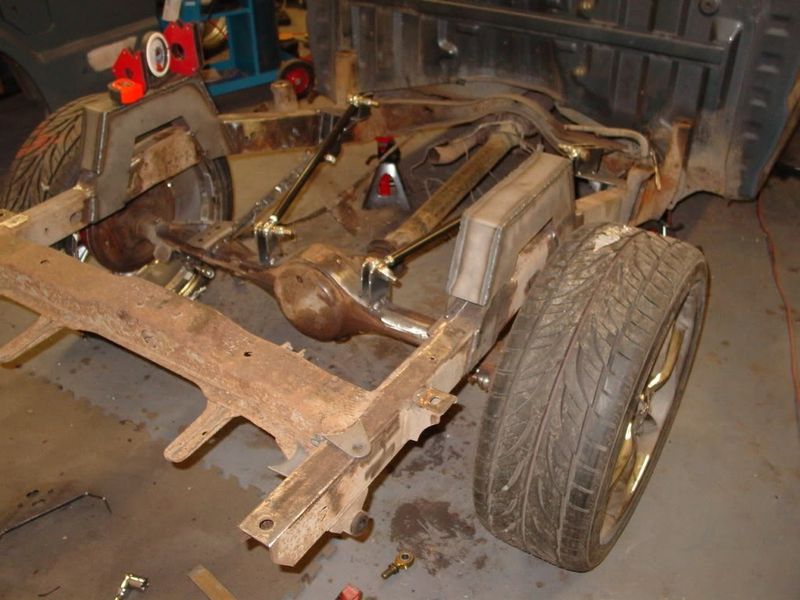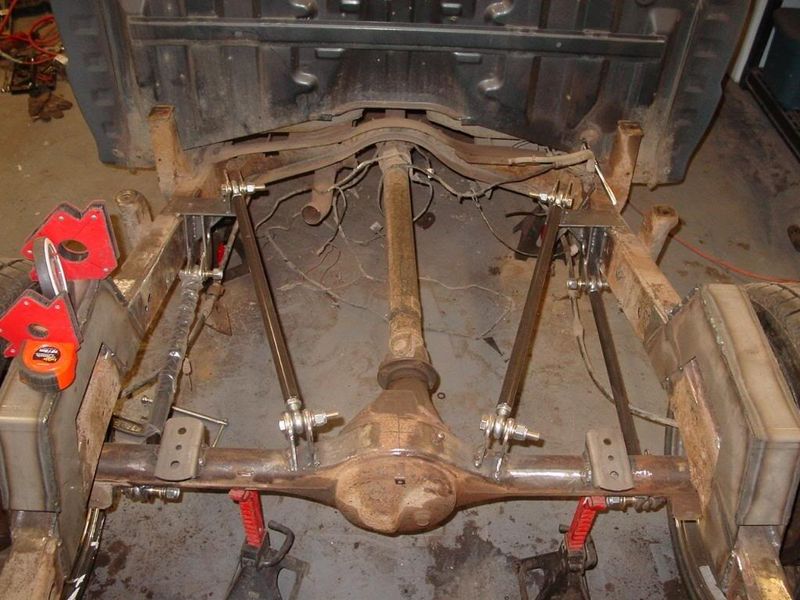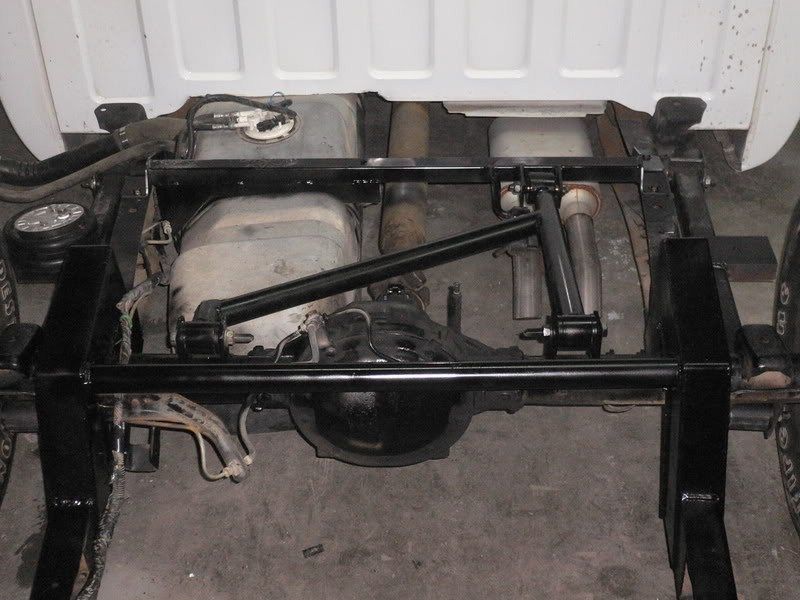
BioMax's 4-link Article

pmiller
+1y
--------------------------------------------- Originally posted by BioMax Just had to post this pic of my shop cat, it makes me laugh every time. She is drinking the mist coming from the hose. ---------------------------------------------Man this is a cool cat. I think it might have inhaled too many shop fumes.



pmiller
+1y
--------------------------------------------- Originally posted by BioMax Just had to post this pic of my shop cat, it makes me laugh every time. She is drinking the mist coming from the hose. ---------------------------------------------Man this is a cool cat. I think it might have inhaled too many shop fumes.

Victim of Corruption
+1y
Edited: 1/24/2009 4:22:58 PM by Victim of Corruption
if u were to run a 'parallel' sytem where both bars arent exactly parallel then it would create an IC right? is this an advantage or is it not worth worrying about. i understand that if the bars arent parallel than it would create pinion angle change but u would get that with other systems anyway. would making the bars angle towards each other putting IC be way out in front of the truck have a noticeable differance than just running them parallel?? also is the IC height meant to be at the grill?? coz that would mean that the lower bar couldnt not be parallel with the ground?
if u were to run a 'parallel' sytem where both bars arent exactly parallel then it would create an IC right? is this an advantage or is it not worth worrying about. i understand that if the bars arent parallel than it would create pinion angle change but u would get that with other systems anyway. would making the bars angle towards each other putting IC be way out in front of the truck have a noticeable differance than just running them parallel?? also is the IC height meant to be at the grill?? coz that would mean that the lower bar couldnt not be parallel with the ground?

BioMax
+1y
Did you read the entire article? I touched on why having some IC is good, it's not necessary, but it is preferred. Would you notice a difference? I can't say. There are thousands of vehicles out there with no shocks and a good handful of the owners would probably argue that the vehicle drives fine. They would not care if the suspension is set up correctly.

OG52
+1y
Edited: 3/2/2009 5:27:07 PM by OG52
hey BIOMAX, this is my first build and i have been taking my time and doing the needed research to accomplish what i have set out to do........... and i have to say that of all the sites and all the bullshit i have read, that this single thread has helped me the most and has given me the not only the set foundation of knowledge to build a half decent truck but the confidence to. so thanks alot not only to you but to all the cats on here that have put in there two cents and not only asked the right questions but gave some insight on said issues......... but now for my question. how does bag placement (on a lower bar, ofcourse) correlate to instant center? what i mean is i know the closer u place the bag to the pivot point of the frame and the lower bar equals more lift, but the ammount of pressure u need to lift it is greater, its simple phisics. and obviously the opposite for further placement. so what im trying to get is, is there some type of math to figure out where is the idel placement for a resonable amount of lift but great ride quality? i now i know some people what 4 billion inches of lift but how does that effect instant center and the relation to the bars and the way the bag lifts the truck. i know the ideal movement of the bag is verticle but with a stationary frame and a moveable bar is that cause for concern? i have seen alot of trucks where the bag drasticly leans to one side causing the opposite side to bellow out.................. p.s. i have a bolt on 3 link from SD and i hate it needless to say this is the reason for me building my own
hey BIOMAX, this is my first build and i have been taking my time and doing the needed research to accomplish what i have set out to do........... and i have to say that of all the sites and all the bullshit i have read, that this single thread has helped me the most and has given me the not only the set foundation of knowledge to build a half decent truck but the confidence to. so thanks alot not only to you but to all the cats on here that have put in there two cents and not only asked the right questions but gave some insight on said issues......... but now for my question. how does bag placement (on a lower bar, ofcourse) correlate to instant center? what i mean is i know the closer u place the bag to the pivot point of the frame and the lower bar equals more lift, but the ammount of pressure u need to lift it is greater, its simple phisics. and obviously the opposite for further placement. so what im trying to get is, is there some type of math to figure out where is the idel placement for a resonable amount of lift but great ride quality? i now i know some people what 4 billion inches of lift but how does that effect instant center and the relation to the bars and the way the bag lifts the truck. i know the ideal movement of the bag is verticle but with a stationary frame and a moveable bar is that cause for concern? i have seen alot of trucks where the bag drasticly leans to one side causing the opposite side to bellow out.................. p.s. i have a bolt on 3 link from SD and i hate it needless to say this is the reason for me building my own

BioMax
+1y
I wrote this a few months ago and it should help answer your question. But first I must point out that bag/spring or shock placement has nothing to do with the instant center. There is one major thing that I see overlooked on most custom suspension systems that one would think to be the most important... Bag type and size. Before we talk about how to choose a bag, let’s explore how air is able to lift a 4000 lb. vehicle with less than 100 psi. Air pressure is rated in pounds per square inch (psi). What that means is that a 1” x 1” x 1” cube with 100 psi of air in it will exert a 100 lb force on all sides. So knowing that, you can do a rough calculation to figure out the lift capability of a bag at a given pressure . Let’s take a generic bag with a top and bottom mounting plate of 5” with only 50 psi. A 5” circle has a surface area of 19.625 square inches, now multiply that dimension by 50 psi and you have a weight carrying capacity of 981.25 lbs. That is a lot considering that you’ll most likely have 2 of them to lift the front end of your vehicle. Now where it gets a lot harder to explain is when you try to calculate spring rate. The spring rate is the amount of weight that it takes to collapse a spring 1”. It is much easier to figure the spring rate on a steel spring (and it’s consistent too) but by the very nature of air, where both volume and pressure need to be taken into consideration, an accurate calculation becomes exponentially more difficult. A large bag will be able to lift more weight, but will have a lower spring rate where as a smaller bag will have less weight capacity but with a higher spring rate. The spring rate is almost directly related to the pressure and the weight capacity is closely associated with the volume. So because a large bag has more volume, it takes less pressure to lift the vehicle and thus a softer spring rate and vice-versa for a smaller bag. With that out of the way, I’ve seen bags that I would personally only use on a minitruck, being used on midsized or even full sized vehicles. But why would it matter? If the part will lift the vehicle and it’s even easier to install, why not use it? There are more things to consider than simply ease of installation. The weight of the vehicle, the leverage ratio that the part will be installed in and the actual intended use of the vehicle are all more important than how easily the part will be to install. (Of course this is assuming that the owner of the vehicle cares how their vehicle is going to ride once it is bagged. There are several companies out there that sell a product that is easy to install and everything else is a compromise.) So how do you pick the right bag for your application? That’s not that easy explain, but then again, is anything that I write about? I would say that the first thing to consider when choosing an air spring is how much weight the bag will be lifting and at what leverage ratio. Most of the time you will end up with 2 or more different sized bags that meet your weight carrying capacity needs. From there you need to decide what the vehicle’s intended use will be. If some handling performance is desired, a smaller part will have a higher spring rate thus offering a more firm ride (this should be accompanied by some good quality shocks or it will just end up bouncy) or if the plush “Cadillac” ride that everyone brags about having, but only few truly do is what you desire, then use a larger bag with slightly more suspension travel.
Many of the bags being made these days have a higher spring rate designed into them by using stiffer or thicker rubber, while changing the style of the bag can lower the spring rate and still keep the weight capacity up. But once again there are far too many variables to fit in to a 1 page column, luckily for most of you the homework has already been done for your vehicle and it is just a matter of weather or not to install the bigger bag or to tolerate the stiff ride for now…
Many of the bags being made these days have a higher spring rate designed into them by using stiffer or thicker rubber, while changing the style of the bag can lower the spring rate and still keep the weight capacity up. But once again there are far too many variables to fit in to a 1 page column, luckily for most of you the homework has already been done for your vehicle and it is just a matter of weather or not to install the bigger bag or to tolerate the stiff ride for now…

OG52
+1y
so lets say u were building a 99 extended cab s10 on 20's non body dropped just laying frame. and you are doing a bag on bar set up. you want a reasonable amount of lift but want a nice plush “Cadillac” ride as u put it. what type of bag would you run, i was thinking along the lines of an RE8. would you agree. i was originaly going to run a firestone 9000 bag because i had them on my truck originally and i loved the way they rode but collapsed they are 4 1/2 in tall and thats alot to accomidate for now what about the placement of the bag on the bar. i have heard dead center (50/50) from some people. i have heard 60/40, 0 being the tab off the frame or crossmember. but like i said before alot of the stuff i have been getting off these other sites is just garbage. hey man thanks for responding so quickly...................

BioMax
+1y
The Slam bags are a stiffer part and should be taken into account when deciding on placement. I typically don't use the 9000 or 9100 sleeve bags on minis because minis don't weigh enough to take full advantage of them. I prefer the Firestone 224c or 2600 bag mounted right in the center of the bar for most applications. If you want a softer ride, move the bag further from the rearend or if you want a more firm ride move the bag closer to the rearend. There isn't one ratio that works for every vehicle. Your needs and vehicle type should determine placement insead of a "rule of thumb" placement.

mazdan22
+1y
Edited: 3/17/2009 2:18:28 AM by mazdan22
Edited: 3/16/2009 1:35:29 AM by mazdan22hey max, I am workin on a bag set up right now, I have a kit from FBI.Its mostly just tacked in.Just want your input before I go ahead an weld it all in solid.I would have preffered a different set up, but this is what I have to work with.Its a bag over axle kit, with 4 link (which I was kinda dissappointed with ,but it'll work)First question, heim joints , overall opinion? In regards to function, durability, longevity, and being in a relatively unprotected environment under the vehicle?I bought a few extra heim joints at the local bearing shop 4 for $175, before taxes, they only carried the one grade, they have grease nipples on them not sure if that is any indication of quality.(5/8")The 4 link set up. I made the bottom bars (shorter set) level at ride height, I read that was best on another hot rod site,I then made my top bars (longer set) triangulated. I set the angle so as to cover as close as possible to the same distance from front to back as the bottom bars, almost level also at ride height.So that will be slightly adjustable with the threading on the heim joints/link bars.I was thinkin that would come in handy to adress any pinion angle issues.I realise now that that gives me no instant center. Because its basically a parallell 4 link with triangulated upper bars. If I have learned anything from you its , instant center = the point at which the top and bottom bars if carried on the same angle over enough distance would intersect , right?And that aquiring instant center is critical to accomplish a decent set up. Ideally around the middle of the grille. Any and all help is grealty appreciated.thanx
Edited: 3/16/2009 1:35:29 AM by mazdan22hey max, I am workin on a bag set up right now, I have a kit from FBI.Its mostly just tacked in.Just want your input before I go ahead an weld it all in solid.I would have preffered a different set up, but this is what I have to work with.Its a bag over axle kit, with 4 link (which I was kinda dissappointed with ,but it'll work)First question, heim joints , overall opinion? In regards to function, durability, longevity, and being in a relatively unprotected environment under the vehicle?I bought a few extra heim joints at the local bearing shop 4 for $175, before taxes, they only carried the one grade, they have grease nipples on them not sure if that is any indication of quality.(5/8")The 4 link set up. I made the bottom bars (shorter set) level at ride height, I read that was best on another hot rod site,I then made my top bars (longer set) triangulated. I set the angle so as to cover as close as possible to the same distance from front to back as the bottom bars, almost level also at ride height.So that will be slightly adjustable with the threading on the heim joints/link bars.I was thinkin that would come in handy to adress any pinion angle issues.I realise now that that gives me no instant center. Because its basically a parallell 4 link with triangulated upper bars. If I have learned anything from you its , instant center = the point at which the top and bottom bars if carried on the same angle over enough distance would intersect , right?And that aquiring instant center is critical to accomplish a decent set up. Ideally around the middle of the grille. Any and all help is grealty appreciated.thanx



sirangel
+1y
this is the setup im thinkin about running, and offset wishbone, for clearance purposes..is this a good setup??..would i still need a lateral movement eliminator?..

Related Discussions in Air Ride Suspensions
Thread
Posts
Last Post

